Conversion
Before starting the company's activities in K2 IS, it is necessary (among other things) to fill in the Articles code list and the Suppl./Cust. code list. It is also necessary to state the initial stocks of warehouses, receivables from customers (balance of invoices outed) and liabilities from suppliers (balance of invoices received). This can be done manually. If the user already used an information system before the implementation of K2 IS, a conversion can be performed, i.e. this data can be transferred from the original software to K2 IS. The conversion tool (script) consists of the following functions (modules), which can be run independently of each other:
- Conversion of Articles and Customers (for further description see chapter Basic Code Lists and Support Modules - Imports),
- Conversion of Balance of Invoices Outed,
- Conversion of Balance of Invoices Received,
- Warehouse Stock Conversion.
All these modules run in the same way:
- The source for any conversion is a table created in a spreadsheet. (In all modules, it is assumed that the data from the original IS is converted to a spreadsheet table, where the first row contains a description of the columns (this row can be empty) and the second row is followed by the data.
- If are input data fields in the user conversion forms. The field name corresponds to a particular K2 IS field. The column name of the spreadsheet table is inserted into this input field, which contains data corresponding to the description (name) of the input field. Fields marked in yellow must be filled in, other fields are optional. (Input data settings in forms can be saved - when leaving the form, you will be asked if you want to save the changes. If case of a positive answer, the form with preset input data is opened for the user the next time the module is started.)
- After filling in the data, press the "Conversion..." button. The form for selection of a file that contains data for conversion is displayed. After pressing the Open button, the data is imported.
- You need to have the right data in your spreadsheet. Although the script checks the correctness of the data and displays error messages, if there is an error in the file that the script does not detect (the record can be saved), then the wrong data is imported. The conversion can be run repeatedly, but new records are always created. The use of conversion is when uploading data from the origin software or to add the data, e.g. by customers the data in databases.
Attention: The conversion tool (script) no longer deletes the default records! If it is an initial import of data, it is advisable to make a backup of the data beforehand, which can be restored in case of incorrect import.
Conversion of Balance of Invoices Outed
The Conversion of Balance of Invoices Outed form enables the transfer of receivables to customers in K2 field. If K2 IS, it is necessary to implement a book (book) "SA - Balance Account Book" for the Sales books in the Book Administration. Script creates free invoices outed in this sales book, item of these invoices is „NEZB 0 %” (General item 0 % VAT - article card no. 1 standardly delivered in the Articles book) in the quantity of "1" and the price of a receivable.
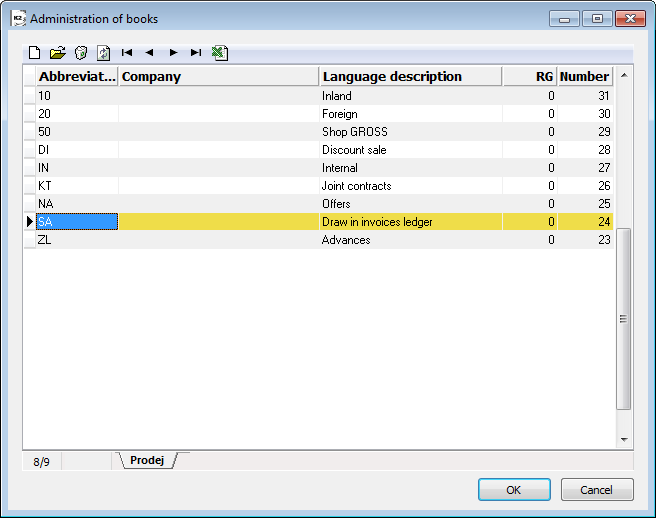
Picture: The 'SA' sale book for inserting of balance of invoices outed.
Example: You want to enter receivables from customers into IS K2. The following excel table is available.

Picture: Excel Table with Prepared Data for Conversion of Balance of Invoices Outed
Column A |
- |
ID-No of a Customer |
Column B |
- |
Customer Name |
Column C |
- |
Date of the Invoice Issuing |
Column D |
- |
Invoice Due Date |
Column E |
- |
Sale Item |
Column F |
- |
Unpaid Amount of a Document in Currency |
Column G |
- |
Tax Point Date |
Column H |
- |
Date of Accounting Transaction |
Column I |
- |
Reference Number |
Column AC |
- |
Document Number in Original Software |
Column AD |
- |
Document Original Amount in Currency |
Column AE |
- |
Currency of a Document |
Column AF |
- |
Exchange Rate |
After running the Conversion script, open the Conversion of Balance of Invoices Outed tab (it is best to run the script in the book of Invoices Outed in the 'SA’ book).
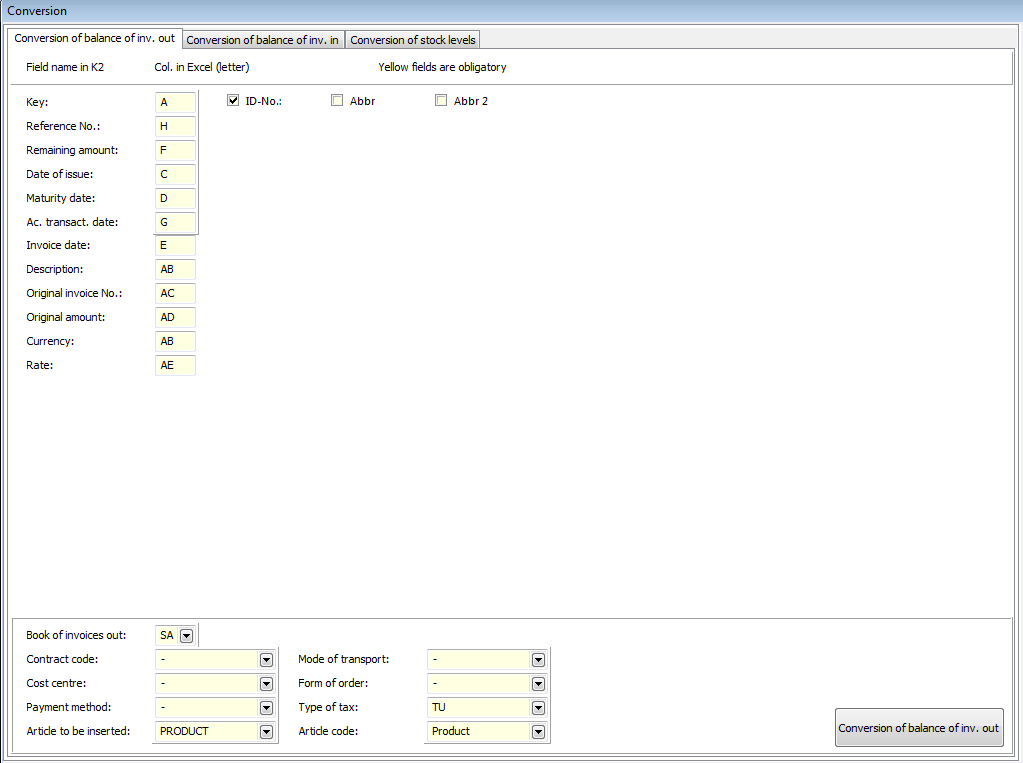
Picture: Form for Conversion of Balance of Invoices Outed
Fields Description:
Key |
Insert the name of a column from Excel containing unique information about the customer. Based on this field, the customer to whom the invoice is outed is searched in the Suppl./Cust. book. By checking the appropriate field, you give information on whether the customer search is performed according to the field ID, Abbreviations or Abbreviations 2. |
Reference Number |
Insert the name of a column from Excel containing the reference invoice number in the original IS. |
Pay Off |
Insert the name of a column from Excel containing amount left to pay in Currency of a Document |
Date of Issue |
Insert the name of a column from Excel containing a date of the invoice issuing |
Due Date |
Insert the name of a column from Excel containing a due date of the invoice. |
Date of Accounting Transaction |
Insert the name of a column from Excel containing a date of an accounting case. |
Tax Point Date |
Insert the name of a column from Excel containing a tax point date. |
Description |
Insert the name of a column from Excel containing invoice description. |
Original Number of Invoice |
Insert the name of a column from Excel containing number of invoice in The original software (data is inserted to note). |
Original Amount |
Insert the name of a column from Excel containing amount in the invoice currency to which the invoice was issued in the original software (the information is inserted in a note). |
Currency |
Insert the name of a column from Excel containing document currency. The currency designation must match the designation in K2 IS (Countries code list). If Excel contains a value that is not in K2 IS, the invoice is saved in the currency of the own company, entered in the Sales book into which it is imported, and a notification is displayed. |
Exchange Rate |
Insert the name of a column from Excel containing document currency. |
Filling in the fields at the bottom is also mandatory. In order to save documents that have these fields blank before conversion, you must define in the conversion form which values the blank fields should be filled in.
After filling in the data, press the Conversion of Balance of Invoices Outed button. The form for selecting the file containing the data to be converted appears. After selecting it and pressing the Open button, the invoices outed are imported.

Picture: Invoices Outed Book - the Result of Conversion
Conversion of Balance of Invoices Received
The Conversion of Balance of Invoices Received form enables the transfer of liabilities to Suppliers to K2 IS. In K2 IS, it is necessary to create a book (book) "SA - Balance Account Book" for the Purchase books in the Book Administration. The script creates unassigned invoices received in the 'SA' purchase book. Item of these invoices is „NEZB 0 %” (General item 0 % VAT - article card no. 1 standardly delivered in the Articles book) in the amount of "1" and in the price of a receivable.
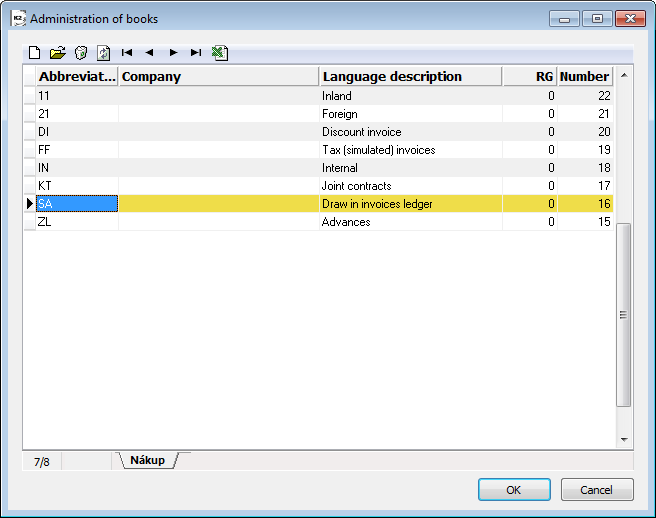
Picture: The 'SA' Purchase Book for Inserting the Balance of Invoices Received and 'IN' for Inserting the Stock Levels
Example: You want to introduce obligations To suppliers into K2 IS. The following Excel table is available.

Picture: Excel Table with Prepared Data for Conversion of the Balance of Invoices Received
Column G |
- |
Customer ID-No |
Column H |
- |
Customer Name |
Column L |
- |
Date of Invoice Issuing |
Column N |
- |
Invoice Due Date |
Column O |
- |
Sale Item |
Column R |
- |
Unpaid Amount |
Column X |
- |
Date of Accounting Transaction |
Column Y |
- |
Tax Point Date |
Column Z |
- |
Reference Number |
After running the Conversion script, open the Conversion of the Balance of Invoices Received tab (it is best to run the script in the Invoices Received book in the 'SA’ book).
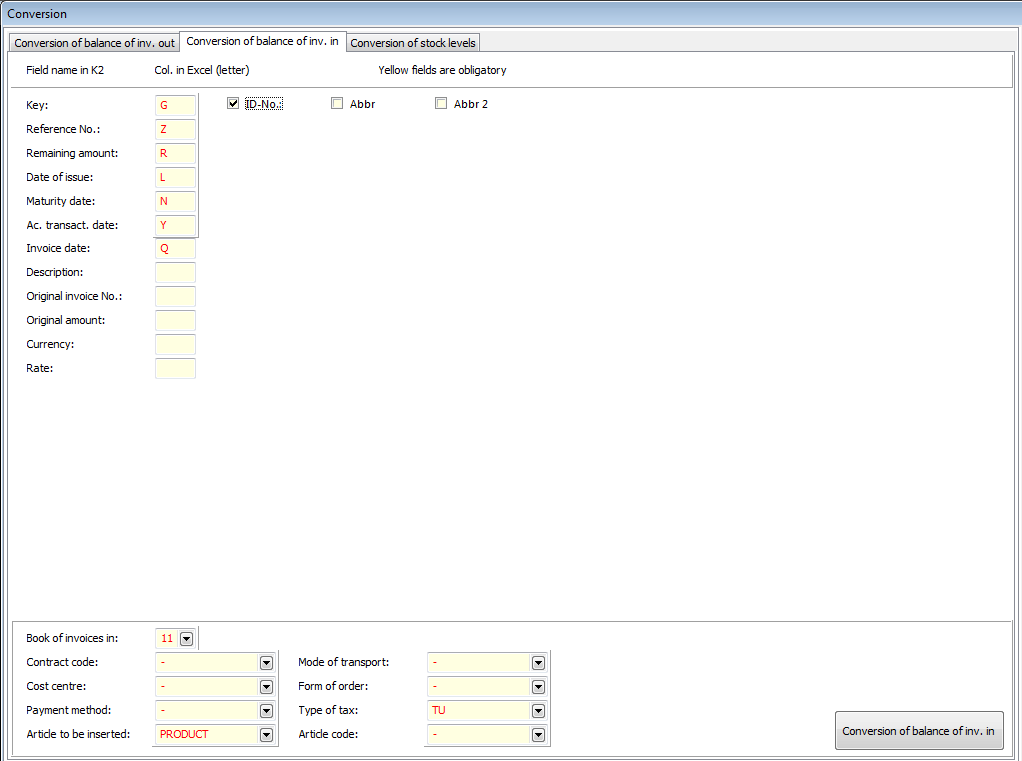
Picture: Form for Conversion of Balance of Invoices Received
Fields Description:
Key |
Insert the column name from Excel containing unique information about customer. Based on this field, the supplier is searched in the book Suppl./Cust., to whom the invoice is issued. By checking the appropriate field, you give information on whether the supplier search is performed according to the field ID, Abbreviation or Abbreviation 2. |
Reference Number |
Insert the column name from Excel containing reference number of invoice received in the original IS. |
Pay Off |
Insert the column name from Excel containing amount left to pay. |
Date of Issue |
Insert the column name from Excel containing a date of the invoice issuing. |
Due Date |
Insert the column name from Excel containing a due date of the invoice. |
Date of Accounting Transaction |
Insert the column name from Excel containing a date of accounting transaction. |
Tax Point Date |
Insert the column name from Excel containing a tax point date. |
Description |
Insert the column name from Excel containing invoice description. |
Original Invoice Number |
Insert the column name from Excel containing number of invoice in the original software (data is inserted in the note). |
Original Amount |
Insert the column name from Excel containing amount for which the invoice was issued in the original software (data is inserted in the note). |
Currency |
Insert the column name from Excel containing the document currency. The currency designation must match The designation in obligations IS (the Countries code list). If Excel contains a value that is not in obligations IS, the invoice is saved in the currency of the own company, entered in the Purchase book into which it is imported, and a notification is displayed. |
Exchange Rate |
Insert the column name from Excel containing document exchange rate. |
Filling in the fields at the bottom is also mandatory. In order to save documents that have these fields blank before conversion, you must define in the conversion form which values the blank fields should be filled in.
After filling in the data, press the Conversion of Balance of Invoices Received button. The form for selecting the file containing the data to be converted appears. After selecting it and pressing the Open button, the received invoices are imported.
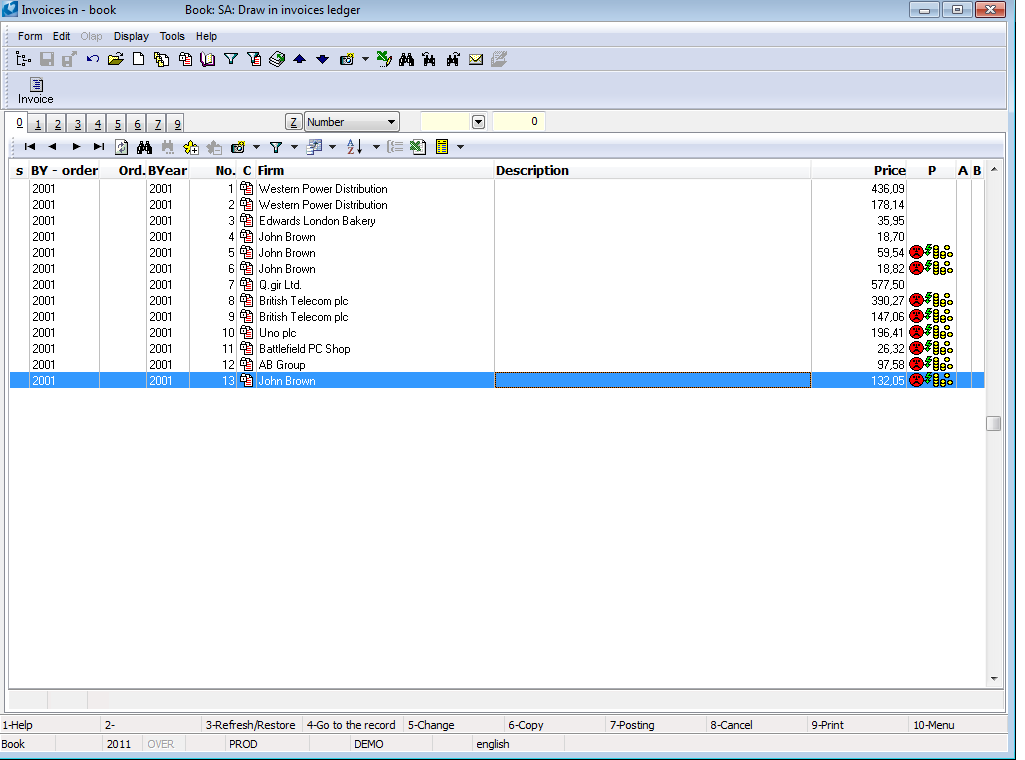
Picture: Invoices Received Book - Result of Conversion
Stocks Levels Conversion
The Stocks Levels Conversion form enables to enter the initial stocks of all warehouses in K2 IS. Both the stock level and the stock price of individual stock items are entered. In K2 IS it is necessary to create a book "IN - Internal book" for the Purchase books in the Book Administration (see the 'SA' Purchase Book for Entering the Balance of Invoices Received and 'SA' for Entering of Stock Levels picture). It is also necessary to enter a card for your own company in the Suppl./Cust. book. The document will be issued for this company. Script creates an unassigned receipt card to the defined stock in the 'IN' book. Enter as many receipt cards as there are different stocks. The stocks has to be defined in K2 IS already.

Picture: Warehouses Book
Example: You want to enter the MAT warehouse inventory into K2 IS. The following Excel table is available.

Picture: Excel Table with Prepared Data for Material Warehouse Status Conversion
Column A |
- |
Article Abbreviation |
Column E |
- |
Amount in Basic Stock Unit |
Column F |
- |
Stock Price for Basic Stock Unit. |
After running the Conversion script, open the Stock Levels Conversion tab (it is best to run the script in the Receipt Cards book in the 'IN’ book).
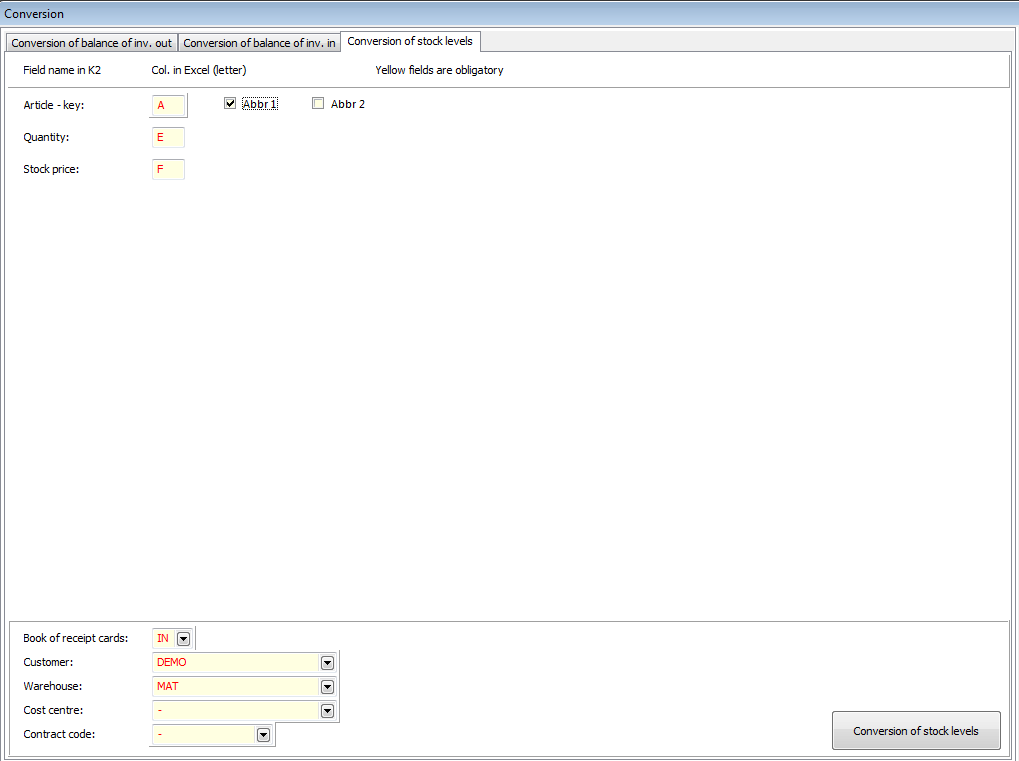
Picture: Form for Conversion of Stocks Levels
Fields Description:
Customer |
Select the card of your own company from the Suppl./Cust. book. Unassigned receipt card will be issued for this company. |
Warehouse |
From the Warehouses book, select the basic stock (NOT summing) to which the status is entered. |
Cost Centre |
Select a cost centre to which the receipt card is to be issued. |
Key |
Enter the column name from Excel containing unique information about article. Based on this field, an article card is searched in the Articles book, which is inserted into the receipt card in the appropriate quantity and price based on the information below. By checking of an appropriate field, you give information on whether the search for the articles card is performed according to the Abbreviation or Abbreviation 2 field. |
Amount |
Enter the column name from Excel containing amount in Basic Stock Unit |
Stock Price |
Enter the column name from Excel containing stock price for basic stock unit. |
Filling in the fields at the bottom is also mandatory. In order to also save documents that have these fields blank before conversion, you must define in the conversion form which values the blank fields should be filled in.
After filling in the data, press the Stock Levels Conversionbutton. The form for selecting the file containing the data to be converted appears. After selecting it and pressing the Open button, a receipt card is created in the 'IN’ book for the defined warehouse. Subsequent confirmation of receipt card (Alt + F2 keys) accepts the articles to the warehouse.
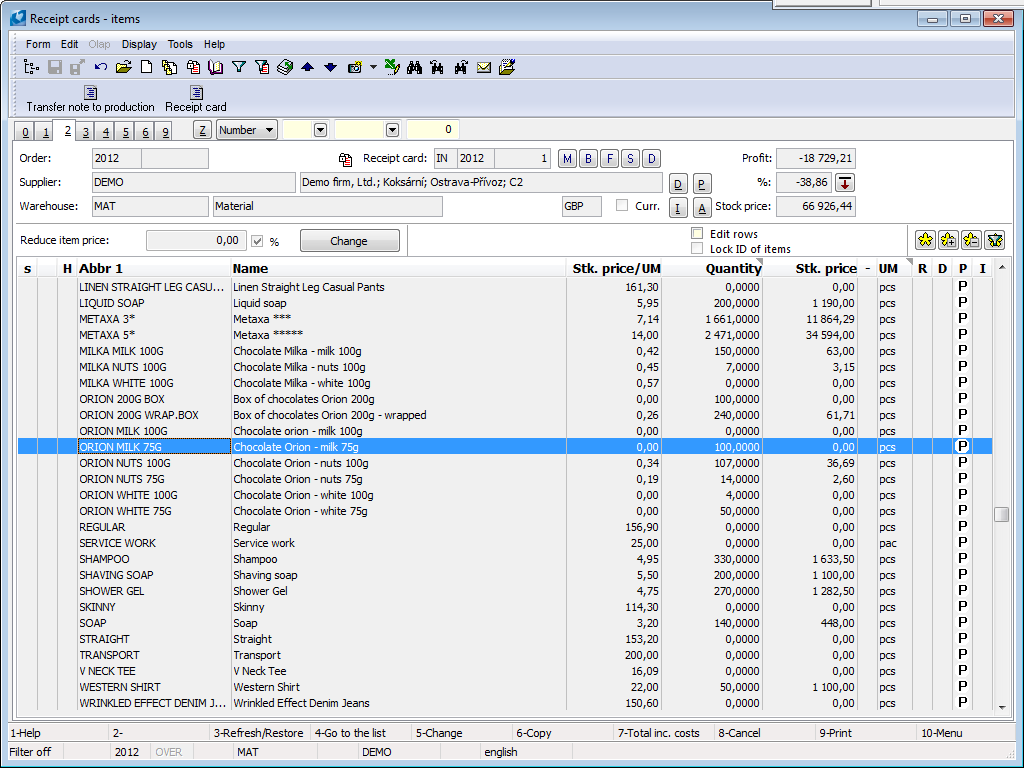
Picture: Receipt Cards Book - Conversion Result